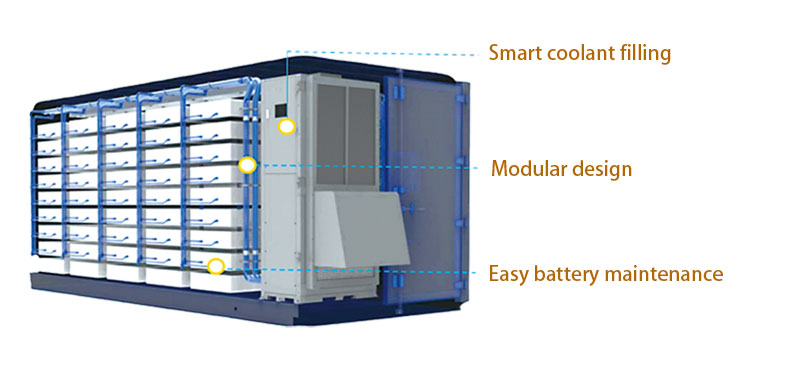Battery Energy Storage System Cooling Solutions: Liquid Cooling VS Air Cooling
Battery Energy Storage System Cooling Chiller is a device used in battery thermal management. Common cooling methods in battery thermal management include air cooling and liquid cooling. So, do you know the difference between these two cooling methods?
There are two thermal management methods for lithium battery units, air cooling and liquid cooling have their own characteristics. Battery Energy Storage System Cooling Chiller can be highly integrated with the battery pack, easy to install on site, occupies a small area, and there is no need to worry about dust, water vapor condensation and other issues. In the case of thermal runaway precursors, the liquid cooling solution can rely on a large flow of cooling medium to force the battery pack to dissipate heat and realize heat redistribution between battery modules, which can quickly avoid the continuous deterioration of thermal runaway and reduce the risk of runaway. The air cooling system has the characteristics of simple system, low manufacturing cost, and easy installation. It is widely used in scenarios where the battery energy density is low and the charging and discharging speed is slow.
1. Under the same inlet temperature and harsh wind speed and flow rate, the temperature of the liquid-cooled battery pack should be 30-40°C, while the temperature of the air-cooled battery pack should be 37-45°C. Liquid-cooled Battery Energy Storage System has better temperature uniformity.
2. In order to achieve the same average battery temperature, air cooling requires several times higher energy consumption than liquid cooling. Under the same power consumption, the temperature of the battery pack is higher for air cooling than for liquid cooling. Liquid cooling consumes less power.
3. Due to factors such as air specific heat capacity and small convective heat transfer coefficient, the heat transfer efficiency of battery air cooling technology is low, and the heat generated by the battery increases, which will lead to excessively high battery temperature and the risk of thermal runaway; the liquid cooling system can greatly reduce the thermal runaway of the battery risk.
4. The liquid cooling system is easier to ensure that the battery works at a comfortable temperature. Compared with the air cooling system, the battery life will be extended, and the investment in liquid cooling is less in terms of the overall life cycle.
The air cooling system has the advantages of small initial investment, low maintenance cost, and easy maintenance. It is more suitable for small civilian or commercial battery thermal management. However, Battery Energy Storage System Cooling Chiller has gradually become a suitable battery cooling method in large-capacity and high-energy-ratio fields such as large ground power stations.
| Air Cooling VS. Liquid Cooling | ||
| Air Cooling | 液体冷却 | |
| heat exchange medium | Air | Liquid |
| drive parts | fan | no fan required |
| heat dissipation | General | The specific heat capacity of the coolant is 1000 times that of air, and the heat dissipation capacity is much higher than that of air cooling |
| energy saving | PUE is within 2.2 | PUE is within 1.2 |
| noise | high noise | low noise due to no fan |
| construction cost | The low-density layout of the cabinets takes up a large area of the equipment room, requiring the use of traditional precision air conditioners and cold and hot pipeline designs. | The high-density layout of the cabinet reduces the occupied area, and the low PUE means that the power supply, power distribution and infrastructure scale facilities are reduced. |
| site selection | It has high requirements on environmental climate and power factors. | It is not affected by the environment and climate, and is not restricted by energy policies, so it can be deployed anywhere. |
製品とソリューション
| モデル | CNYL -45 |
| 冷却能力 | 45KW |
| 温度制御精度 | ±0.5℃ リアルタイム温度記録 |
| 二次冷媒 | エチレングリコール不凍液、冷媒循環システムの完全密閉設計 |
| 冷媒 | R410A |
| フロー | 300L/min~400L/min 設定表示履歴 |
| 低圧電気 | シュナイダー/シーメンス |
| 表示画面 | 7インチカラータッチスクリーン |
| パワー | 380V 50HZ は 220V60HZ 460V 60HZ を選びます |
| シェル素材 | 冷間圧延シートスプレー REL7035 |
| 内部配管 | SUS304 |
| モデル | CNYL-5 | CNYL-8.5 |
| 冷却能力 | 5KW | 8.5KW |
| 精度 | ±0.5℃ リアルタイム温度記録 | ±0.5℃ リアルタイム温度記録 |
| 最低水入口温度 | 15℃(バッテリーシステムによりカスタマイズ可能) | 13℃(バッテリーシステムによりカスタマイズ可能) |
| システム圧力センサー検出 | 液体出口圧力、液体入口圧力、冷凍システム高低圧力 | |
| COP | *2.0 | *2.2 |
| コンプレッサー | ハーメチックコンプレッサー(1セット) | 34cm3/rev完全密閉式スクロールコンプレッサー(1セット) |
| 冷媒 | R410A | R410A |
| ディスプレイ | 7インチカラータッチスクリーン | 7インチカラータッチスクリーン |
| 動作周囲温度範囲 | -45℃~55℃ | |
| 制御電圧範囲 | 18-32V | 18-32V |
| 冷凍高圧最大出力 | 2.2KW | 3.5KW |
| 冷凍機の平均投入電力(kW) | +1.5kwadjustable頻度 | +2kwadjustable周波数 |
| COP | *2.0 | *2.2 |
| モデル | CHDYL-4 |
| 冷却能力 | 4KW |
| 精度 | ±リアルタイム温度記録 |
| コンプレッサー | ハーメチックコンプレッサー(1セット) |
| 冷媒 | R134A |
| ディスプレイ | 7インチカラータッチスクリーン |
| 制御システム | PLC |
| コミュニケーション | CAN |
| 動作周囲温度範囲 | -45℃~55℃ |

温度制御システムの設計から製造まで。標準モデルから完全なカスタマイズ製品まで 1000トン.私たちはカスタマーサービスに特化し、お客様一人ひとりのニーズに合った最適な温度制御システムを提供することに専念しています。
非標準のカスタマイズされたソリューションを提供します。
Eメール info@lneya.com WeChat ID: +8615251628237 WhatsApp: +86 17851209193

 LNEYA
LNEYA
 简体中文
简体中文

















































































